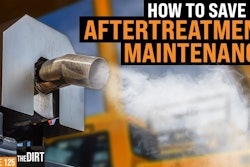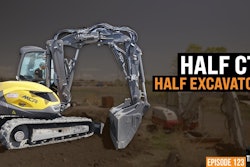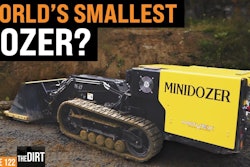For a week, host Bryan Furnace and guest Rick Valko put an X12 Steelwrist tiltrotator through its paces clearing two and a half acres with an 8-metric-ton excavator.
On this episode of The Dirt, the two operators give their views on its performance as well as deliver insights on the attachment that twists and turns. You also get to see plenty of footage of the Steelwrist in action.
Their first concern was a common one heard among U.S. contractors, “Is it strong enough?”
The device answered that with a resounding “yes” and provided a host of other benefits beyond that of a traditional bucket and thumb.
“This thing is just unreal,” Rick says.
Bryan calls it “one of the most fun attachments” he’s ever run.
On the job, the device ripped out trees and moved boulders and dirt with outstanding efficiency, power and safety. The 8-ton excavator was performing like a 15-ton machine and also increasing production in the process. With an experienced operator, they estimate the tiltrotator can increase efficiency by 20% to 30%.
There are also a quite a few other benefits – and a few concerns – operators should be aware of that they explain.
So to find out why a tiltrotator will change the way you think about a job and why neither of these guys wanted to give the demo model back, check out this episode of The Dirt.
Equipment World serves up weekly videos on the latest in construction equipment, work trucks and pickup trucks – everything contractors need to get their work done. Subscribe and visit us at equipmentworld.com!
In This Episode:
00:00 - Steelwrist Tiltrotator Comprehensive Review Overview
01:12 - Tree Work
02:09 – Safety
02:35 - Cleanup & Efficiency
04:06 - Power & Durability
06:19 – Pinchers
07:11 - Swapping Attachments
08:40 - Learning Curve
11:09 – Controls
11:36 - Room for Improvement
13:34 - Final Verdict
Bryan Furnace (00:00):
What's going on everyone? Welcome back to Equipment World. You're watching The Dirt. I'm your host Bryan, and today I have a guest operator, my buddy Rick from Diesel and Iron is with me today and we are here to review the Steelwrist, and this review is going to be a little bit different as you guys are familiar.
(00:26):
Normally we go to the facility of whoever we are reviewing. We run it around their kind of test area and then we come back and give you a recap of the day. Steelwrist very generously donated this machine to us for a week and they told us to work it and so that is exactly what we did.
(00:41):
One of the biggest areas of pushback that I have ever heard from the American market when it comes to any sort of tilt rotator attachment is they're not strong enough. They'll never hold up to what we do here in America. That's always what you hear. And so we really wanted to test that theory and so we have not been gentle on this machine at all.
Rick Valko (00:58):
We've been working on about two and a half acres of land clearing. We've put this thing through its paces. This thing's been ripping trees down, it's been moving boulders and dirt. This thing is just unreal.
Bryan (01:13):
Most people are kind of generally familiar with tilt rotators for dirt work. Where it's really shined for us is in the tree work. Tell us a bit about what you've been doing.
Rick (01:21):
Absolutely, so we're able to actually manipulate the trees. The best way I can describe it is you got a 30, 40% radius from the machine that you don't have to constantly track around over stumps or in between trees. Because this will rotate you can manipulate the wrist on the trees and you could grab a hold of these things and really place them where you want versus the conventional thumb and bucket. It's a lot more dangerous, right? Because the way the angles go.
(01:47):
This thing right here changes the game for tree work, at least for us today and yesterday. When you want to talk about safety and efficiency, this thing right here is efficient and is a lot safer to take trees down than the old style.
Bryan (02:07):
That is one of the biggest areas that's actually been a surprise is the safety aspect. Especially doing tree work because of the ability you have to manipulate the trees. With a traditional bucket and thumb, you really can only push in one direction. You don't have a lot of guidance on the tree as it's falling down versus, as Rick just said, with this, you can manipulate the tree all the way down to the ground and then talk a little bit about cleanup. That's where it really shines.
Rick (02:32):
So the way we've been going about it is we're actually sitting there, we're logging the woods out or really no room in the area where we're at when you first kind of get started. This thing is able just to basically fish to log right out to you and it'll suck it right to you. You could chug it up, you could log it, you could sort the logs out, the stumps out, and then the brush, right?
(02:52):
And then going back to how efficient this thing is, instead of having a guy roaming around the job site anymore, I could keep them kind of tucked in a safe zone and I could bring the log and the brush, everything right to him.
Bryan (03:04):
Rick was able to manipulate the tree around to him without any danger while he did his cuts and then he was able to throw it back into the area we had designated for mulching. I mean it was just a really efficient process.
Rick (03:15):
A hundred percent.
Bryan (03:16):
We knew that it was going to make us more efficient. Generally everyone that I've ever spoken to that uses a tilt rotator says right off the bat, you can pretty much eliminate the need for an extra laborer and a lot of times you can eliminate the need for any sort of cleanup machine when you get an operator that's pretty accurate with these because you get to do all of the finished grading and you can get your bucket into whatever orientation you need to get the grade done that you want.
Rick (03:39):
They've really put a lot of thought into this of how an operator really could finesse what they're doing. You put this in the right hand of a seasoned operator, you're going to watch production probably, I'd have to say 20 or 30% more efficient with-
Bryan (03:53):
Easily.
Rick (03:54):
... just this combination here and we haven't even hit the learning curve yet.
Bryan (03:57):
Yes.
Rick (03:58):
It's just been a couple days roaming around.
Bryan (04:04):
The actual Steelwrist itself was the big question mark. I know for me, I'm sure you as well.
Rick (04:10):
I mean when you look at this, this is beefy.
Bryan (04:12):
Yeah, this isn't going to go anywhere.
Rick (04:14):
When you look at this contraption basically right here with all these moving parts-
Bryan (04:18):
That's where the worry comes in.
Rick (04:19):
Yes. The biggest hang-up for me was this is so complex I'm going to destroy something. I'm going to break something. The force of just prying. This thing is just built. It's sophisticated. There's a lot more thought behind this than it just even looks like.
Bryan (04:34):
By the way, I have talked to the folks at Steelwrist. These will hold up to a hammer. Now obviously like anything else in our industry, it's going to get wamped out a lot faster if you're running a hammer on it. But you're also not just going to break this thing if you put a hammer on it, they are designed for the demo industry and they will handle a hammer.
(04:50):
The Steelwrist attachment itself is really strong and what we're showcasing kind of here is the grapple itself and this grapple just how stout this thing is built the size of trees Rick was taking down with this thing, impressed everyone on the job site. This is an 8-ton machine and we were taking down trees that really, I would've felt more comfortable in a 15-ton machine. Absolutely. With a traditional thumb and bucket.
Rick (05:14):
Absolutely.
Bryan (05:14):
And yet this machine was able to handle them just fine.
Rick (05:16):
The prying and the breakout force with this, you think you're going to just lose so much, but it's actually a lot stronger than just a regular bucket with a thumb.
Bryan (05:31):
The hydraulic layout on this, one of my big paranoia when we first started running this thing, I thought for sure we were going to snag a line. And now working in the woods, we have had a couple close calls as you would expect working with trees. But if you guys had seen the way we've been using this thing, I'm shocked we have not snagged a line.
Rick (05:48):
Well, you're a hundred percent right. It's because the capabilities are running these things. Once you start getting comfortable-
Bryan (05:53):
That's where you're going to [inaudible 00:05:55].
Rick (05:54):
A little more dangerous, but at the same time you start getting that much more efficient.
Bryan (05:58):
Yes.
Rick (05:58):
I mean we went to the point where I just started snapping top of trees and throwing them on the ground.
Bryan (06:03):
And yet we haven't snagged any lines to the point that we've torn anything. We haven't ripped any of the actual casings and covers that are protecting. I mean it is really well-designed.
(06:17):
These are some of the most handy things to have on your machine. We went from thinking we may use those once or twice to-
Rick (06:25):
Constantly.
Bryan (06:26):
... We're using them all the time. The cool thing is when you have a bucket attached here, the bucket will be facing back towards the machine. And so if you have something you need to pick up and move out of your way, you can just rotate the bucket 180 degrees. So it's facing up and away from the machine, which now puts your pinchers down towards the ground. And so you can very delicately, and by the way, you have a phenomenal amount of control with these pinchers. You can very delicately grab whatever you need to.
(06:52):
I picked up a piece of PVC pipe with no issue the other day. That's how precise you can be with these. Move it out of the way, rotate your bucket back into operating position and you never had to leave the seat.
Rick (07:03):
It's smooth.
Bryan (07:04):
It's so smooth, it's so handy.
(07:09):
Let's say you're a contractor, you want to baby the Steelwrist because these are expensive attachments, no problem. You have your quick disconnect lines right up here along with your electronics. Those are a quick disconnect. And then you can go back into the cab of your machine and your quick coupler in the machine now operates your regular standard machine, quick coupler.
(07:28):
Now you can drop the entire Steelwrist detachment off of the machine, swing over to your hammer, your bucket, whatever you're going to use. Couple up to that, use it and then you can come right back to the Steelwrist and hook back up to it. Now that's option number one.
(07:43):
Option number two, Steelwrist also offers their SQ package. That actually has a wet kit that will interface directly with the coupler with a button inside the cab. You uncouple, it doesn't even require you unhooking lines, everything unhooks as you disconnect. And you also have an SQ coupler at the bottom end as well so that if you're using your grapple or whatever, you can hook right into the attachment and all of your hydraulics are immediately live as, like I said, you can also disconnect from inside the cab.
Rick (08:12):
So you're saying there's no downtime for an operator out here wrestling an attachment around?
Bryan (08:17):
Let's change that around because cost is such a factor. You as an operator making $60 an hour. I'm not paying you to get out and beat pins out of this thing for 15 minutes to switch your attachment over. The nice thing is, as an operator at $60 an hour, you're sitting in the cab the whole time. That's the advantage of the SQ system.
(08:38):
If you're thinking about purchasing one of these attachments, you do need to recognize that you or any of your operators, you're going to have about a two-day period where you have to learn how to run the machine again for a couple reasons.
(10:08):
One, you now have a lot more controls on your joysticks, which we're going to get to here in a second. The second thing is you have to relearn how to run the machine. We're used to this very one dimensional drag a bucket flat across the ground concept and now you've added two extra dimensions. That's a lot to wrap your mind around.
Rick (10:24):
It took us about four or five hours even to understand this attachment and get comfortable with the controls, which is its own animal there.
Bryan (10:30):
With that being said, about two days in the seat and we were very comfortable with this attachment.
Rick (10:35):
You're a little hesitant. You're like, what's this going to do? Because it's complex. You got a lot of moving parts here. So you're like, well, how much can I really get away with this? And you start building that trust and comfort on when you start taking down these trees. To the end of today, I had a couple trees left that we know were going to lose this machine that I was actually starting to get away from the comfort of going back to a bigger machine with a thumb and a bucket because I was able to manipulate everything with this right here.
Bryan (11:07):
If you purchase a Steelwrist attachment, Steelwrist will take your machine and they actually take the joysticks out and they put Steelwrist joysticks in and that actually integrates with your machine's computer. So you can do some really cool things because you've got a ton of buttons and those can be programmed to actual machine functions, whether it's grade control system, your radio, your wipers. You tell Steelwrist, what you want to control and they can put it on your joysticks.
(11:34):
Now unfortunately, with the design of the joysticks, they're very comfortable in your hand. I have no complaints there, but Rick and I are both operators that tend to use our fingertips with our hands more over the joystick and with the way Steelwrist joysticks are set up, you are using your entire hand for all of the functions and you actually walk your hands around the joystick.
Rick (11:55):
Yeah, you're caressing that constantly to use both rotators.
Bryan (11:58):
Yes. And that is just a point that I could see a little better design coming down maybe in the future to make everything just a little more accessible from a fingertip standpoint. But again, that's a real nitpicky thing and that's also a lot operator preference.
Rick (12:12):
Well, I think it's just like a boot size. We all have different size feet.
Bryan (12:15):
Absolutely.
Rick (12:16):
I don't think you need different size controls for big hand, little hand.
Bryan (12:19):
Absolutely. So that being said, let's flip over to the grapple.
Rick (12:23):
So we don't have the SQ package on this right here. This thing, this grapple is under pressure right here. A couple of things that I've noticed instantly is when we wanted to switch out from this to the bucket was we didn't have the bump fittings on it, so we had to shut the machine down and kind of bleed this off. We had to take the wrenches and crack the lines, just relieve the pressure.
Bryan (12:43):
On the... Just to clarify, on the grapple side, the grapple holds pressure.
Rick (12:46):
A lot of pressure.
Bryan (12:47):
Yes.
Rick (12:48):
So it could be improved or tweaked a little bit. However, or personally we could do it on our own if we own the attachment ourself. Just needs to be able to relieve the pressure because this thing, you cannot plug it back in once you disconnect it.
Bryan (12:59):
There's probably some way you set this grapple that you won't have the pressure build up. We have tried it fully open, we've tried it fully closed and every time we've had to crack the fitting. So unfortunately that has been a bit of a pain.
Rick (13:10):
Absolutely. The other thing that really just kind of stuck out to me personally was the tilt cylinders that rock this thing back left to right, just because we're up in the brush and the debris constantly, it almost needs some kind of guard for the cylinder just so it don't get nicked or dinged on where it creates a future prom down the road.
Bryan (13:29):
Agreed.
(13:33):
I can't say enough good things about this. This is one of the most fun attachments I have ever run, and this is one of the times I can truly say I don't want to give a demo back. This has been an absolute joy to run. It has changed the way you think about the job. That's been one of the most shocking things is everyone's familiar with a tilt rotator. Everyone's familiar with kind of the versatility that it offers. But when you actually get one on the job site, you start to think about the job entirely differently. The way you approach it, the way you approach cleanup, the trees, again, the way that it's changed, the handling of the trees.
Rick (14:05):
If you guys are doing more than just dirt work and you're doing boulder walls and you're doing a little bit of tree work, anything like that, give this thing a look. Try it for a week and I almost guarantee you won't want to give this thing back like we don't.
Bryan (14:17):
100%. So as always, thanks for watching. I hope this helps you and your business. We'll catch you guys on the next episode of The Dirt.
Rick (14:24):
Thanks guys.









